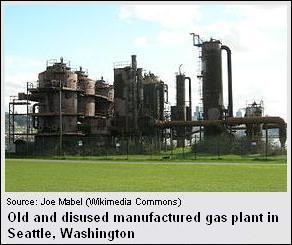Industry (main)
From The Encyclopedia of Earth
(Redirected from Industry (Industry))
Contents
Industry
========
-
 Featured Article
Featured Article  Iron, Steel and Cement ProductionIron and steel manufacturing is the largest industrial source of greenhouse gases, contributing about 7% of the world’s emissions from human activities. This stems from... More »
Iron, Steel and Cement ProductionIron and steel manufacturing is the largest industrial source of greenhouse gases, contributing about 7% of the world’s emissions from human activities. This stems from... More »
Recently Updated
 Iron, Steel and Cement Production Last Updated on 2010-12-16 00:00:00 Iron and steel manufacturing is the largest industrial source of greenhouse gases, contributing about 7% of the world’s emissions from human activities. This stems from the vast amounts of energy required for iron and steel smelting (purifying iron or steel from iron ore) and from several chemical reactions that directly generate CO2. Earth’s crust contains deposits of iron ore, which is composed of iron combined with oxygen (e.g., iron hematite, Fe2O3) or sulfur (e.g., iron pyrrhotite, FeS, and iron pyrite “fool’s gold,” FeS2). Blast furnace for iron and steel smelting Iron ore (primarily iron oxide), coke (purified coal), and limestone (primarily CaCO3) is fed into the top of the furnace, where iron forms from the reaction of the ore with carbon monoxide (CO). In the middle of the furnace, a reaction of carbon dioxide (CO2) with the carbon in... More »
Iron, Steel and Cement Production Last Updated on 2010-12-16 00:00:00 Iron and steel manufacturing is the largest industrial source of greenhouse gases, contributing about 7% of the world’s emissions from human activities. This stems from the vast amounts of energy required for iron and steel smelting (purifying iron or steel from iron ore) and from several chemical reactions that directly generate CO2. Earth’s crust contains deposits of iron ore, which is composed of iron combined with oxygen (e.g., iron hematite, Fe2O3) or sulfur (e.g., iron pyrrhotite, FeS, and iron pyrite “fool’s gold,” FeS2). Blast furnace for iron and steel smelting Iron ore (primarily iron oxide), coke (purified coal), and limestone (primarily CaCO3) is fed into the top of the furnace, where iron forms from the reaction of the ore with carbon monoxide (CO). In the middle of the furnace, a reaction of carbon dioxide (CO2) with the carbon in... More »  Solar power (Industry) Last Updated on 2010-04-25 00:00:00 Solar power is any process that generates electricity from the sun's radiation. There are two chief technologies for such electrical production: (a) photovoltaics (PV), where solar panels convert sunlight directly to electrical current; and (b) concentrating solar rays to boil water, which is used to provide power. In spite of the enthusiasm for solar plants in a few western countries, the technology requires significant subsidies to compete with fossil fuels, hydroelectric and nuclear power alternatives; in point of fact solar power supplied a mere .0002 of the world power supply as recently as 2008. Although solar is classified as a renewable energy source, there are some significant environmental impacts, including the generation of toxic cadmium residues and the significant destruction and fragmentation of natural habitats. Strides are being made in terms of... More »
Solar power (Industry) Last Updated on 2010-04-25 00:00:00 Solar power is any process that generates electricity from the sun's radiation. There are two chief technologies for such electrical production: (a) photovoltaics (PV), where solar panels convert sunlight directly to electrical current; and (b) concentrating solar rays to boil water, which is used to provide power. In spite of the enthusiasm for solar plants in a few western countries, the technology requires significant subsidies to compete with fossil fuels, hydroelectric and nuclear power alternatives; in point of fact solar power supplied a mere .0002 of the world power supply as recently as 2008. Although solar is classified as a renewable energy source, there are some significant environmental impacts, including the generation of toxic cadmium residues and the significant destruction and fragmentation of natural habitats. Strides are being made in terms of... More »  History of the manufactured and natural gas industries in the USA Last Updated on 2009-01-27 00:00:00 The historical gas industry includes two chemically distinct flammable gases. These are natural gas and several variations of manufactured coal gas. Manufactured gas should not be confused with natural gas, the primary fuel gas of our day. Manufactured, or artificial gas, was produced from coal, petroleum oil or mixtures of coal and oil. The first attempts to manufacture gas on a commercial basis were made in the late 1700s and early 1800s by Phillippe Lebon in France and by William Murdoch in England. Natural gas is composed primarily of methane, a hydrocarbon composed of one carbon atom and four hydrogen atoms, or CH4. As a "fossil fuel", natural gas flowing from the earth is rarely pure. It is commonly associated with petroleum crude oil and may contain other hydrocarbons including ethane, propane and butane. In the United States,... More »
History of the manufactured and natural gas industries in the USA Last Updated on 2009-01-27 00:00:00 The historical gas industry includes two chemically distinct flammable gases. These are natural gas and several variations of manufactured coal gas. Manufactured gas should not be confused with natural gas, the primary fuel gas of our day. Manufactured, or artificial gas, was produced from coal, petroleum oil or mixtures of coal and oil. The first attempts to manufacture gas on a commercial basis were made in the late 1700s and early 1800s by Phillippe Lebon in France and by William Murdoch in England. Natural gas is composed primarily of methane, a hydrocarbon composed of one carbon atom and four hydrogen atoms, or CH4. As a "fossil fuel", natural gas flowing from the earth is rarely pure. It is commonly associated with petroleum crude oil and may contain other hydrocarbons including ethane, propane and butane. In the United States,... More » 


